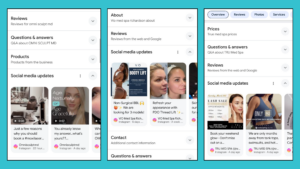
You must look beyond physician referrals to acquire more patients for your medical practice. Patients now use digital channels to proactively research their conditions and choose physicians they want to see. This means you have to think differently about how to attract patients to your clinic.
Don’t believe you’ll get more patients through self-referral? We work with a spine practice that sees 70% of office visits and surgeries from self-referring patients acquired through digital marketing.
This kind of new patient growth only happens through a comprehensive digital marketing strategy.
In the patient acquisition guide below, you’ll find 45 digital marketing strategies to attract more patients to your practice. Some of these you may be familiar with.
Still, I guarantee many of them you won’t find anywhere else, including creative ways to increase patient volume. RUNNER has built these strategies with our extensive medical practice marketing experience to drive thousands of leads and millions in practice revenue.
Know what information you’re looking for? Click the link to take you right to the data. If not, keep reading.
(1-13) Invest in Advertising
(14-19) Publish Content
(20-27) Optimize Your Website
(28-31) Build Out Your Practice & Physician Listings
(32-35) Optimize Your Front Desk
(36-48) Find Innovative Ways to Connect with Patients
Ready to Get More Patients
45 Ways to Attract New Patients to Your Practice
Invest in Advertising
1. Target with Google PPC Ads
Target those searching for your practice, physicians, treatments, and conditions with Google PPC Ads.
Yes, you should buy your brand and physician names even if you already appear in the results. Not only does it protect you from competitors who might buy your brand name, but research has also shown that you’ll receive more traffic than if you only appeared organically.
Google search ads are the most targeted way to get new patients for your practice. That’s because they reach patients actively researching the conditions you target or seeking the treatments you provide. These searches will most likely convert any digital marketing tactic into new patient office visits. They’re also low-risk, as you only pay when someone clicks on an ad.
More like this: Google Ads Benchmarks for Medical Practices (with Real Data!) and What’s A Good Conversion Rate for Medical Practices?
2. Expand Your Google PPC Ads to Bing
Once you’ve established a Google search ad campaign that’s working well and maxed out on spend, how can you get even more patients into your practice?
You should consider creating a Bing search ad campaign to grow your leads. Bing currently has around a 7% market share in the US, so that Bing will have additional search traffic with a small buy. In addition, the cost-per-click is much cheaper than Google. At a minimum, you should buy your brand name searches to protect your brand.
3. Target Site Visitors Who Don’t Convert with Remarketing
Most potential patients will not convert on the first site visit. Remarketing campaigns allow you to target visitors who don’t become leads to your site. All major digital ad platforms include remarketing — we’d recommend starting with Facebook.
More like this: Google Ads Benchmarks for Medical Practices (with Real Data!

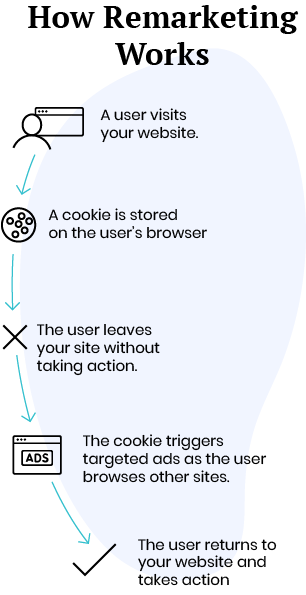
4. Target Engagers With Remarketing
Remarketing isn’t just for those who visit your site. An often overlooked remarketing strategy targets those who engage with your social ads. This means targeting people who like, comment, or even watch a video for a certain amount of time. Remarketing ensures you’re not wasting advertising spend on potential patients that aren’t interested and that you continue to target those who do.
More like this: How to Get More Patients With Facebook Ads
5. Get New Patients with Facebook Advertising
How to get new patients with Facebook?
Facebook provides the most extensive reach of any digital platform. However, organic Facebook posting isn’t enough. As Facebook has become a “pay-to-play” platform. Advertising on Facebook should be a core part of any medical practice marketing campaign. Therefore, it’s essential to experiment with ad types and targeting.
One essential targeting strategy is lookalike audiences. You use Facebook’s algorithm to find more patients that look like those submitting leads or your current book of patients.
More like this: 3 Things We Learned Managing $1 Million in Facebook Advertising and Facebook Ads for Medical Practices [14 Best Examples]
6. Find Potential Patients with YouTube Ads, Pay Only When Someone Views
Next to Facebook, Youtube has the next most significant reach, but more importantly, the average session time on YouTube is 40 minutes – MUCH longer than any other platform.
The ad types include video and text, and skippable ads ensure you don’t pay if someone skips your video ad. Another thing that makes YouTube unique is its targeting. Unique targeting includes targeting ads on YouTube using patient searches on Google and targeting based on potential patients viewing on YouTube.
More like this: 16 Types of Medical Marketing Videos
7. Use Content to Attract Patients Through Native Advertising
Most native ads appear as “related content” on new articles, as pictured in the screenshot below. They can be used effectively by medical practices that feature ads promoting blog posts related to conditions and treatments. Essentially, you’re using the content to attract your most qualified patients. Native ads are highly cost-effective and can drive a high volume of traffic.
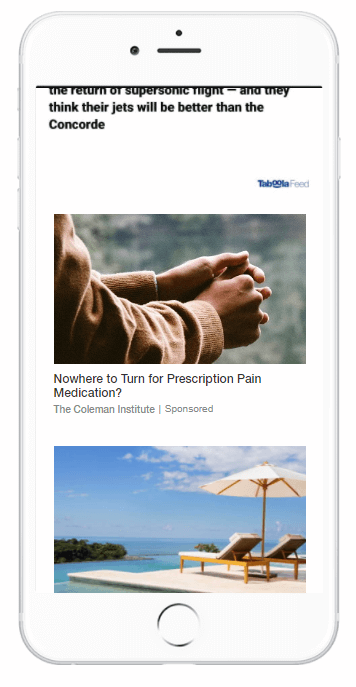
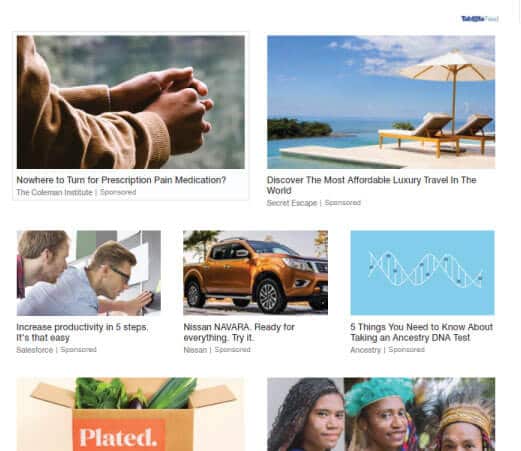
8. Advanced Patient Targeting with Programmatic Advertising
One of the most targeted forms of digital advertising is programmatic. What makes programmatic advertising unique is the use of advanced third-party data for targeting ads.
Programmatic platforms are essentially marketplaces where advertisers can bid on ads, and specify the target audience they’re going after – which includes more sophisticated targeting. Here are some examples of the kinds of things you can target using programmatic.
– OTC pharmacy purchase behavior
– Propensity models for specific conditions
– Self-reported PPO insurance
This is the same type of advertising that pharmaceutical manufacturers use, now made accessible for a medical practice marketing strategy.
More like this: Programmatic Advertising For Medical Marketing
9. Find More Similar New Patient Leads with “Lookalike” Targeting
Most advertising platforms now offer “lookalike” targeting. This involves tasking an algorithm to analyze millions of data points to target those people who “look” like your ideal new patient lead.
These algorithms are “trained” on data you provide, such as the visitors to your site or those who submit leads. This type of targeting has become one of the highest performing and is extremely easy to set up.
Lookalike targeting is available on most digital ad platforms for medical practices, including Facebook, Instagram, Google, Youtube and more.
10. Expand Facebook Ads to Instagram
If you’re already running Facebook ads successfully, expand your ad placements to include Instagram. Since Facebook owns Instagram, it’s as simple as checking a box and can expand your reach dramatically. However, remember that sometimes you need to customize your creative for best practices on Instagram.
More like this: Facebook Ads for Medical Practices [14 Best Examples]and How to Get More Patients With Facebook Ads
11. Buy Google Search Keywords on Youtube
Google owns Youtube, so it has some great ad formats that many advertisers don’t know about.
One is Youtube’s “custom intent audiences,” – which allows you to target Youtube ads based on Google Search behavior. So if you have keywords you’re doing well for on Google, chances are they’ll work well on Youtube.
And remember, Youtube is considered the second largest search engine next to Google, so potential patients may be searching on Youtube as well.
12. Run Google Local Services Ads
Google Local Services Ads are a way for medical practices to run locally targeted ads that show up when people search for relevant services you offer in your area. Then potential patients can call, send a message request or schedule an office visit directly through the ad.
What makes Google Local Services Ads unique is they allow practices to only pay for leads.
In addition Google verifies advertisers, allowing your practice ads to stand out with a “Google Guarantee or Google Screened” badging, as pictured below.
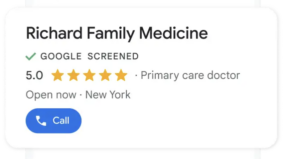
It should be noted that only some medical specialties are eligible for Google Local Services ads, including:
Allergist, Chiropractor, Dentist, Dermatologist, Dietician, Opthamologist, Optometrist, Orthodontist, Physical Therapist, Podiatrist and Primary Care.
13. Experiment With Google Performance Max
Publish Content
14. Start Publishing Blogs
One of the most important long-term strategies for medical practices to acquire more patients is to begin creating content. This is most easily achieved through starting to publish blogs.
The hardest part of blogging is consistency. Establish a posting cadence you’re comfortable with — we’d recommend monthly, finding numerous folks in your practice that can contribute, or hiring an agency to create content. Make sure you’re creating content that answers patient questions.
More like this: 4 Must-Haves in a Healthcare Content Marketing Strategy
15. Post Updates on Your Google Business Profile Listings
If you create blog posts, post them on your Google Business Profile listings for the practice. You have the ability to create “posts”, as pictured below.
This is a great way to make your GBP listing stand out and signal Google for local search listings. Make sure they include the keywords you want to target!
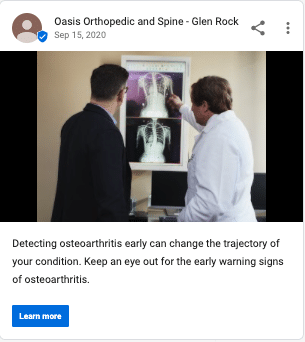
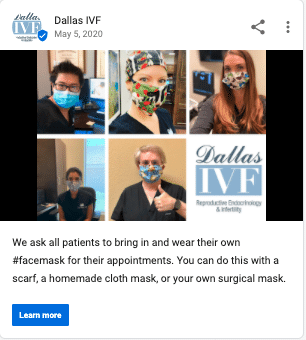
16. Update Old Blog Posts
If you’ve already been posting to your blog, an often-overlooked strategy is to update existing blog posts that can improve in rank with a bit of updating. Unfortunately, even blog posts that rank well will “decay” as Google views them as less relevant the older they are. So make sure you’re adding new paragraphs.
More like this: 4 Must-Haves in a Healthcare Content Marketing Strategy
17. Create Downloadable Content to Capture Leads
Downloadable content is a great way for practices to provide valuable patient education materials to identify your best leads.
For example, a “treatment guide” is a great way to explain questions a potential patient might have about a procedure they’re researching. Still, it also allows you to capture some lead information to nurture that prospect into a patient.
Producing downloadable content is also a way to ask qualifying questions in the form submission that might tell you if the patient is qualified. Such as the timeframe they’re looking to seek treatment.
More like this: 4 Must-Haves in a Healthcare Content Marketing Strategy
18. Publish Regular Video Content
Video content is one of the best ways to empathize with potential patients and build trust for your practice and physicians through education. Make sure you allocate a budget to promote your best video content with paid advertising.
For example, in a recent advertising campaign, we saw a 3.3x increase in leads submitted through video ads vs. text ads.
More like this: Guide to Video Marketing for Doctors: How to Get Started
19. Add Videos To Your Site to Increase Dwell Time
Video content is also a great addition to crucial site pages, as it increases the amount of time people spend on your site. This is called “Dwell Time” and is an essential measurement of quality that Google uses when determining how pages rank in SEO. For example, we’ve seen practice websites increase rankings and traffic by adding educational content about conditions or treatments.
More like this: 16 Types of Medical Marketing Videos
Optimize Your Website
20. Make Your Phone Number Prominent
One common mistake we see medical practices make is not displaying the phone number prominently in the navigation on their website.
This simple addition will SIGNIFICANTLY increase your leads overnight.
More like this: 10 Things Patients Want From Your Medical Website
21. Offer Form Submissions, Not Just Calls
Suppose you’re not offering another way for patients to contact you other than a phone call. In that case, you’re also missing out on incremental leads you’re not getting today. At the very least, consider adding the ability for patients to request an appointment.
More like this: 3 Easy Ways to Automate Your Medical Practice Front Office
22. Exit Intent Pop-Ups
These pop-ups are a great way to capture leads from visitors before they leave your practice site. However, they only pop up when a visitor signals their intent to close the browser or navigate away from your site.
More like this: Beyond Default Forms: Better Lead Generation Tactics [Video]
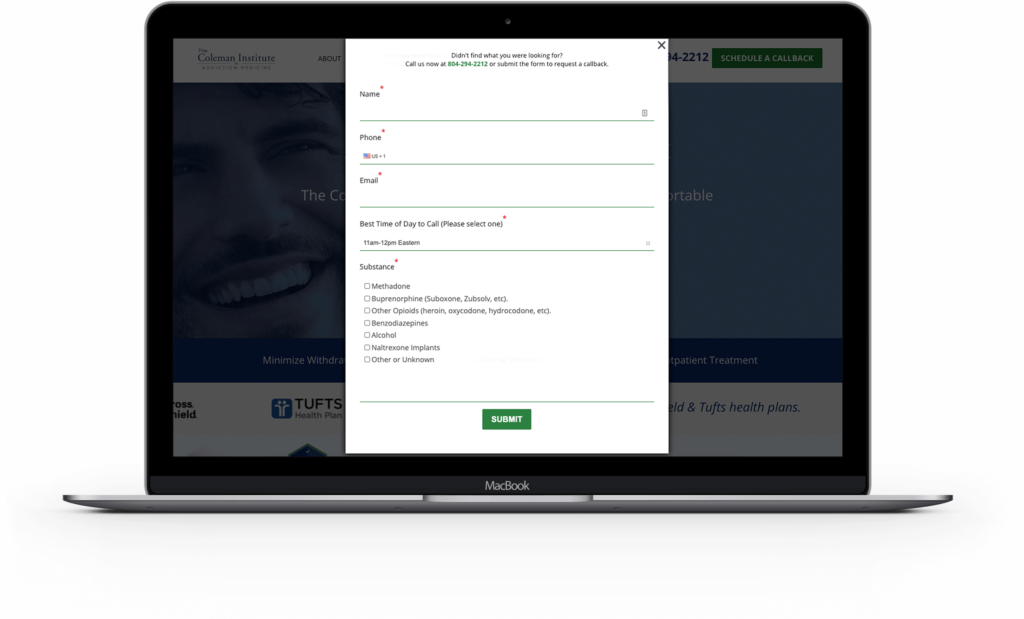
23. Add a Chatbot to Your Site
Chat is a great way to drive leads, especially after hours when your front desk does not take calls. You don’t need a live person answering chats 24 hours a day. Instead, you can create a chatbot on your website to answer the most common questions and direct visitors to call during business hours or submit a lead.
More like this: Building A High-Performing Medical Practice Website
24. Rethink Your CTA
While many of your patients will call, many others will not. Think of your website’s primary “call-to-action” as your cash register. Rather than “contact us” CTA, think about adding CTAs that are more tied to your primary goals with the website.
One of the best CTAs you can have is “schedule an appointment” and allow visitors to self-schedule. Another example of a great CTA is “verify your insurance” — for visitors who may be considering your practice but are unsure if you take their insurance.
One of the CTAs we include for many of our Spine & Orthopedics practices is a “pain assessment” form.
More like this: Beyond Default Forms: Better Lead Generation Tactics [Video]
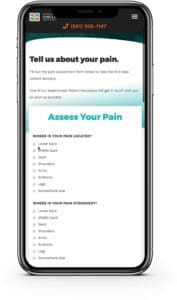
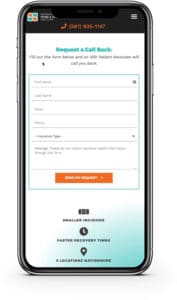
25. Add Educational Videos
Educational content is significant as patients take a more proactive approach to research conditions and treatments. Therefore, we encourage practices to create educational videos and blog posts to better connect with your practice.
In addition, educational videos can be transcribed and repurposed in blog posts, and Education videos can use shorter clips in advertising.
For example, we added a video to a recent client’s site. We increased the time spent on their website by 25% and the overall lead conversion rate by 23%.
More like this: Guide to Video Marketing for Doctors: How to Get Started
26. Showcase Physicians
Creating trust with patients is difficult if you’re not showcasing your physicians. This means not just having website pages with bios for each physician, but also making sure critical pages like the homepage and key conversion pages showcase your physicians. Unfortunately, medical practices that don’t showcase physicians have lower conversion rates.
27. Add High-Quality Patient Testimonials to Your Site
Patient testimonials are table stakes. Yet many medical practices either don’t include them or only have them in ways that come off as inauthentic — like anonymous text testimonials. High-performing practices will take the time to generate video testimonials.
More like this: Online Reputation Management for Doctors Your 2022 Guide
Build Out Your Practice & Physician Listings
28. Expand Your Google My Business Listings
Google My Business Listings are important ways practices can quickly generate more patient leads. Yet, many medical practices have local listings with incorrect information or incomplete profiles. The more built out your profiles are, the more likely you will rank well for local searches and motivate potential patients to call or click through to your site. Make sure you include photos use the content updates.
Just getting started? Wondering how to attract patients to a new practice? Google Business Profile listings is one of the single most important marketing strategies next to getting your website built.
29. Create Physician Directory Listings
While most practices have created Google My Business listings, they don’t always generate physician listings. According to Google, if you have multiple physicians in practice, you should have BOTH a practice listing and a listing for each physician. This will increase your overall visibility in searches.
30. Create More Practice & Physician Reviews
Your practice should have a plan to generate a high volume of patient reviews. This involves automating your outreach, so you’re constantly asking for reviews without doing outreach manually. It also means having a strategy for WHEN to ask for reviews and screening reviews using an NPS (Net Promoter Score), so you’re only asking for reviews from patients who’ve had a positive experience.
More like this: How To Grow Your Patient Reviews
31. Connect Social Profiles to Your GBP Listings & Begin Posting Regularly
Optimize Your Front Desk
32. Re-engage Past Patients
Instead of worrying about how to increase patient volume in your medical practice, an easy way to immediately impact revenue is to drive past patients back to the practice. Re-engage past patients through email nurturing, SMS, and phone outreach.
One of the biggest areas of loss for most practices is not being able to get existing patients to follow-through with scheduling treatments, or come back to the practice for additional medical needs.
33. Re-engage Cold Leads
It’s also vital to re-engage cold leads that may have delayed seeking treatment or continue researching a provider. Practices can also re-engage these leads through email nurturing, SMS, and phone outreach.
Understanding why these leads didn’t convert to tailor your message appropriately is essential.
So, for example, if you know a potential patient started feeling better or just wasn’t ready, those messages would be more personalized than truly cold leads that you don’t know anything more about.
You must also be persistent.
Remember that patients screen their phone calls differently now, with many calls going to voicemail. Because of this, it often takes more phone calls to reach them. Yet many practices give up after just a few attempts. So keep calling — try different times and days of the week.
How to get patients to respond? Our recommendation is at least 12 touches over two weeks.
More like this: How to Fix Your Medical Practice Call Center and Stop Losing Patients
34. Email Nurturing Sequences
Email outreach to re-engage prospects or patients should include email nurturing. This means a sequence of emails to move a prospect towards scheduling an appointment. Email sequences can explain treatment in more detail, address objections, provide patient testimonials, and more. They can also be triggered by actions like a repeat visit to your website.
More like this: Why Email is (Still) Your Single Greatest Determinant for Inbound Marketing Success
35. Use SMS to Interact with Prospects
Many practices are still not using SMS as a part of practice communications. Yet SMS open rates are as high as 98% and response rates as high as 46%. Simply put, potential prospects are MUCH more likely to see a text message than an email. We include it as an essential part of our marketing campaigns for medical practices.
More like this: How to Securely Text Message Patients

SMS

Find Innovative Ways to Connect with Patients
36. Get Involved in Facebook Groups
Patients increasingly turn to social media to learn more about conditions and treatments. Facebook Groups are a popular place for patients to discuss diagnoses and treatment options. In addition, physicians can be great places to provide valuable patient education and build your reputation.
More like this: Six Social Media Tips For Medical Practices
37. Create Your Own Facebook Group
There’s also the opportunity for practices to create their own Facebook Group. For example, if you don’t find any existing groups around your particular specialty or if you want to create a local version of a larger group. Keep in mind that this tactic must be considered a long-term endeavor and involves some nuance to ensure your approach is not overly promotional or running afoul of group rules.
More like this: Six Social Media Tips For Medical Practices
38. Host “Virtual” Informational Events
Suppose your specialty involves a good amount of education. In that case, one possible strategy is to hold “virtual” information sessions to generate leads. Think of these as “webinars” for patients. These can be pre-recorded and replayed monthly, as long as you have someone attend them to field questions. This approach can lead to more qualified patients who clearly understand your offer.
Remember, you need to use paid advertising to promote these events.
More like this: Think Your Content Doesn’t Need Paid Social Promotion? Think Again.
39. Broadcast Live Video on Social
Live video on social media is an excellent opportunity for potential patient education. You get all the great benefits of video without production hassle — no editing is needed.
In addition, live videos can be archived so prospects can watch whenever they want. It’s important to remember that most views will not happen during the live broadcast but afterward. After the fact, high-performing practices will spend some advertising dollars promoting these videos.
More like this: 16 Types of Medical Marketing Videos
40. Amplify Your Physician Referral Outreach
Most practices haven’t evolved their approach to physician outreach. While you may have staff dedicated to these efforts, practices can use digital marketing to support them, such as LinkedIn or Facebook advertising to target a specific list of target physicians or other referral sources.
Reach out to an expert at RUNNER to learn more about these advanced advertising tactics.
41. Custom Lists for Paid Advertising
If you already have a list of physicians, you’re targeting for referrals. You can use it in paid advertising and target ONLY them. This custom list advertising is available across many platforms — we’d recommend LinkedIn and Facebook.
More like this: How To Use LinkedIn For B2B Healthcare Marketing
42. Physician NPI Targeting
Through programmatic advertising, in addition to custom lists, you can do advertising that targets the specific NPIs of the physicians you’re targeting. You can even tell in reporting which physicians are engaging with your ads so you know how to target your outreach efforts.
More like this: Programmatic Advertising For Medical Marketing
43. LinkedIn Advertising
LinkedIn is the most fruitful advertising for most digital marketing targeting physicians. In addition to using custom lists above, you can use LinkedIn to target specific practice groups, for example.
More like this: How To Use LinkedIn For B2B Healthcare Marketing
44. Create a Course
Education is one of the primary ways that physicians build trust. One way to get more patients is to provide a better education than your competitors through an online course. It’s never been easier to create an online course with video content, and the patients you acquire from a course will have much better knowledge when you see them for that first office visit.
45. Start a TikTok Account
There are several medical practices seeing success creating TikTok accounts. Unlike other social platforms, the TikTok algorithm ensures that every piece of content gets the chance to be viewed, with the most engaging content surfacing to the top.
Why TikTok? Because it’s the fastest growing social platform in the last several years and has already amassed more than 80 million US users.
Medical conditions and treatments have become a popular topic. Here are some examples of the number of views for key medical hashtags:
- #backpain – 3.5B views
- #surgery – 15.4B views
- #doctorsoftiktok – 5.2B views
- #addiction – 5.9B views
We’ve seen many medical practices build a large following and hundreds of thousands of views on TikTok through organic posting.
46. Run TikTok Ads for Your Practice
In addition to creating an account and posting, you can also run TikTok ads for your medical practice. TikTok ads are very cost-effective compared to other ad platforms. They include ad formats that allow patients to submit leads directly from your ads. Targeting for these ads consists of standard dimensions on other platforms. For medical practices, this means interest and hashtag targeting for the conditions and treatments you want to prioritize and demographic targeting.
One key limitation: TikTok ads cannot yet be targeted down to the zip code, only the city.
But your ad creative is the most important factor when running ads on TikTok. So what ads perform best for your practice? TikTok publishes a library of high-performing ads. You can sort by industry to see the highest performing medical practice ads. You can view their TikTok ads library here.
47. Partner With Influencers
For some practices, such as med spas or other cash pay businesses, there’s an opportunity to partner with influencers that reach your target audience to get more exposure for your practice.
This may be in the form of either payment, or more often, providing services in return for the influencer posting about your practice. Keep in mind that all such partnerships must be disclosed, per the FTC’s endorsement guidelines.
48. Create a Tool
Tools can be a great way to engage with patients, helping them get answers to pressing questions, but also generating a lead for your practice. Some examples of tools include:
- Condition assessments – these tools help potential patients understand the severity of their symptoms, and can help create urgency for patients to schedule an appointment. Example – a “pain assessment” for a spine practice.
- Cost calculators – help patients understand variables that can contribute to cost. These may be especially important for elective or cash-based specialties. Example – filler cost calculator for an aesthetics practice.
Ready to Get More Patients?
Bonus – Hire an Expert to Develop a Patient Acquisition Strategy
While all of the above digital marketing strategies will help you attract more patients to your medical practice, it’s often difficult to understand which you should prioritize for your practice.
With the help of healthcare marketing experts like RUNNER, you can understand where to invest your time and advertising. We know how to increase patients in your clinic, and grow your medical practice.
Request a free consultation today if you’d like to speak with an expert about turning your medical practice into a patient acquisition machine.
Last Updated: 11/29/2023



